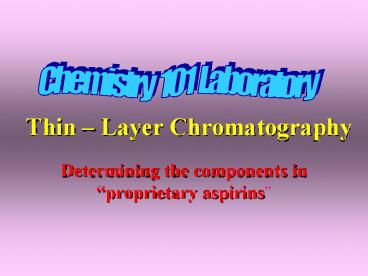Thin Layer Chromatography - PowerPoint PPT Presentation
1 / 15
Title:
Thin Layer Chromatography
Description:
Place 5 6 mL of TLC solvent into a 100 150 mL beaker. ... firmly into the top of your column; then, fire polish the sharp, ragged tip. ... – PowerPoint PPT presentation
Number of Views:3291
Avg rating:3.0/5.0
Title: Thin Layer Chromatography
1
Thin Layer Chromatography
Chemistry 101 Laboratory
- Determining the components in proprietary
aspirins
2
Place 5 6 mL of TLC solvent into a 100 150 mL
beaker.
- Cover the beaker with a watch glass or a piece of
Parafilm.
3
Heat a melting point capillary over a very small
flame.
- Rotate the capillary evenly with BOTH hands until
the center softens and sags.
4
Remove the capillary from the flame and pull . . .
- Hold it for a few seconds until the glass cools
and re-sets.
5
Snap the capillary in two at the center.
- Now you have TWO spotters . . .
6
IMAGINE the origin line on the TLC plate
just above the solvent level in the beaker.
- Place four evenly spaced dots on the origin
line, and identify the proposed spots at the top
of the plate.
7
Place samples of the unknown AND references into
spotting plates
- Dip a spotter into a sample a bit of liquid is
drawn into the capillary.
8
Touch the spotter to the plate a bit of sample
will wet the dot.
- Blow on the spot to hasten drying..
9
Place the plate into the developing beaker
replace the cover.
- It should take 10 15 minutes for the solvent
front to reach the top.
10
While your TLC plate is developing, you should
prepare to turn in your Column from your last
lab.
11
First poke a wad of cotton rather firmly into
the top of your column then, fire polish the
sharp, ragged tip.
- Label the column with your name, and turn it in
with your lab report.
12
Allow a few minutes for your plate to dry then
examine it under the UV lamp.
- The components will appear as purple spots on
greenish background but will NOT be visible once
the lamp is turned off.
13
With a sharp pencil, circle the spots while under
the light.
- Identify the components by comparing their
positions with the references.
14
Show your results to your instructor.
- If the results are not satisfactory, it will
only take a few minutes to repeat the procedure.
15
Complete the lab Report form as shown.
- Clean up your lab station before leaving the
laboratory.

